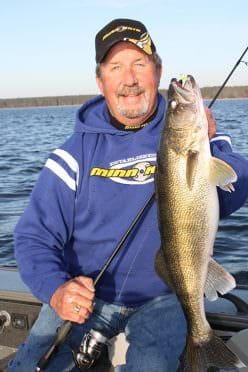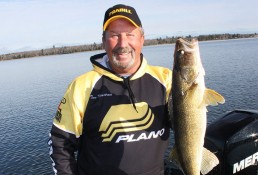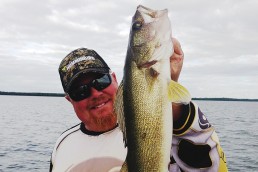Crossing Over and Keeping Up with Walleyes for Summer
SHARE THIS POST
There always seems to be a “season for the right reasons,” when things below the surface of the water dictate change. The many variables walleyes adapt to will tip you off to proper depth, location and presentation keys.
Many times, we don’t understand what lies below the water’s surface and what makes walleyes routinely adapt to a countless number of variables. We have learned so much, but still have doors to unlock and have to challenge our own intelligence so we can become better walleye anglers.

As the drips of spring renew another season of our pursuit of walleyes, some staple techniques will likely produce, as always. For decades, the jig and minnow combination has been our bread and butter for contacting and catching walleyes of every size and shape. After the spawning ritual is over, walleyes are on the hunt for food, making them vulnerable to simple but well-planned delivery systems.
I have been a jig fisherman for decades, having been taught by a gentleman wise beyond his years. He would say to me: “You are the music, so make the jig dance.” He taught me several retrieves that I still use today.
The jig-and-minnow window can last several weeks after the spawn and into the pre-summer, but at some point you have to switch things up or cross over to new techniques primed to produce.
Right tools for jigging
Jig styles vary, but there are standards that work year after year. I like the VMC Mooneye jigs because of their sizes, colors and nasty-sharp hooks. This series lets me choose a longer-shank hook, which is also good for fishing plastics. Later in the season, when the weeds are at their peak, I like to snap-jig through heavy cover with minnow-type plastics. That approach helps me cover water quickly, looking for aggressive walleyes and keeping pesky panfish bites to a minimum. Color sometimes is the least important part of the equation, but I am partial to shades of green and UV patterns on both jigs and crankbaits.
Rods and reels are a whole different ball game when it comes to jig fishing. I like medium-action, 6-foot 8-inch rods with a rather fast tip. My favorite is the Daiwa DXW 681. I can fish jigs in an array of situations and have the muscle to battle the feistiest walleyes on the planet.
Are you enjoying this post?
You can be among the first to get the latest info on where to go, what to use and how to use it!
With most jigging presentations I am casting, drifting or slowly trolling with my electric motor. I connect up my depth finder/GPS to the electric motors using the i-Pilot link on the Minn Kota, so I stay on fish. Walleyes can be nomadic, but really don’t travel far once they are on food.
Ideas on jig weights
I like to change up jig weights to match conditions and situations. I don’t have a rule of thumb on weight, but sometimes there are reverse issues that force me to use light or heavy jigs that go against the grain. Many times, I will work fish with a heavier jig because I can move it faster to trigger strikes, but often switch to a much lighter jig in the same depth when walleyes give me the thumbs down. One other trick is to downsize my minnow or plastic bait and give walleyes a sniff rather than the whole big meal.
Crossover time
Crossing over to the next part of the puzzle is more of a “transition” than a total change. As the walleyes move to their pre-summer and summer locales, presentations will change and baits will be altered to accommodate. As a guide, I don’t necessarily chase walleyes during this time with all the same presentations; I let the walleyes tell me what they want. Often, I will mix and match delivery systems with a jig and minnow, slip-sinker rigs with leeches or nightcrawlers, and bottom-bouncers and spinners with live bait or plastics. Depths might vary from as shallow as 4 feet to perhaps 20. Please keep an open mind regarding what will work best. Walleyes are pure predators and food is their driving force for location. They can also change their preferred diet in a heartbeat.
During the progression from post-spawn to summer walleye locations, casting smaller crankbaits in shallow areas can work wonders. Keeping in mind that early baitfish are on the smaller side, crankbaits like the Ultra-Lite Shad, size #4 or #5 Shad Raps, Shadow Rap Shad and Storm Smash Shad.
We are provided with an unbelievable choice of tools to provide numerous opportunities to catch walleyes. Choosing the proper techniques for any given situation has become much easier. Crossing over from one to another will up the odds that you show walleyes what they want during this time period.
Book a day on the water with Tom Neustrom at mnfishingconnections.com.
MWO
SHARE THIS POST
Did you enjoy this post?
You can be among the first to get the latest info on where to go, what to use and how to use it!



